Contents
Albatrellus merging is an annual mushroom with good edible qualities. To correctly recognize it in the forest, you should study the photographs and description of the mushroom, as well as understand what species it may look like.
Where does albatrellus merging grow?
You can meet the mushroom mainly in Siberia and the Urals in Our Country. Albatrellus grows mainly on acidic soils, it is found both in coniferous forests among moss and in mixed plantings. You can meet him alone, but more often the mushroom grows in large groups of several copies.
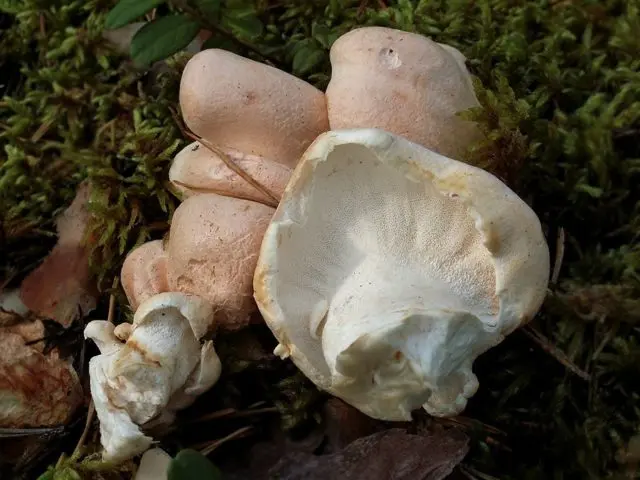
The maximum fruiting occurs in August and early September, and in general, merging albatrellus grows from early July to early November.
What does merging albatrellus look like?
Merging albatrellus is also called fused, as well as tinder fungus. The name is due to the fact that most often several fruiting bodies grow close to each other, as if growing together with legs or the edges of the cap, which is why they turn into a shapeless mass up to 40 cm in diameter.
The hat of albatrellus can have a different shape – rounded, uneven, elongated in one direction. The diameter of an individual cap usually does not exceed 15 cm, its surface is smooth at a young age, and rough in the adult, with small scales in the central part. Old mushrooms may crack. In color, the tinder fungus is usually merging cream or yellowish-pinkish, sometimes slightly reddish, with age – red or brown-pink.
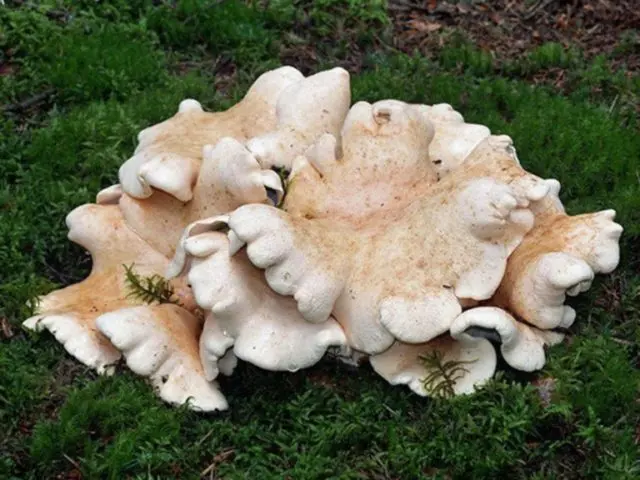
The underside of the mushroom cap is tubular, white or cream, and after drying it is pink or red-brown. The pores on the lower side are different in shape – angular and round, small.
On the leg, the tinder fungus merging usually rises 5-7 cm above the ground. Its leg is fleshy, but brittle, up to 3 cm in diameter, cream or slightly pinkish in color. The pulp of albatrellus is white and firm when broken, becoming reddish when dry.
Is it possible to eat albatrellus confluent
The merging tinder fungus is completely suitable for food consumption. You can even eat it raw, but more often the mushroom is boiled or fried, this allows you to remove from the pulp the likely toxins accumulated during its growth from the soil.
The taste of the mushroom
According to connoisseurs, the merging tinder fungus has a rather pleasant taste. It is used not only in assorted mushrooms, but also in a separate form – in hot and cold dishes, in salting and pickling. The advantage of merging albatrellus is that after processing its flesh remains pleasantly elastic.
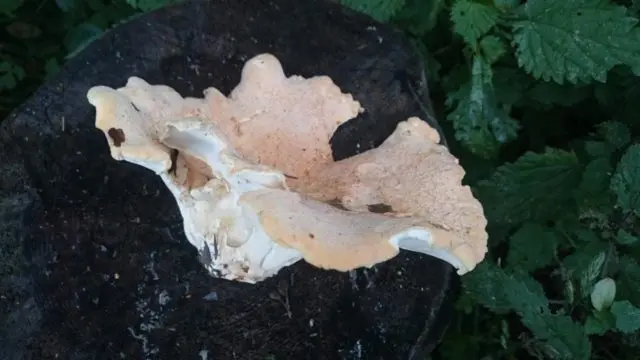
Raw albatrellus has a neutral odor and a slightly sour or bitter taste. During processing, these flavors disappear.
Benefits and harm to the body
Eating a merging tinder fungus is good for health – the fungus has a diverse chemical composition and valuable properties. In particular, when used, it:
- strengthens the immune system and makes the body more resistant to viruses and colds;
- has an antitumor effect and serves as a prophylaxis of oncological neoplasms;
- has a mild analgesic effect and helps relieve inflammation;
- improves the functioning of the exchange system;
- prevents the development of anemia and helps build healthy muscle mass.
Albatrellus accrete contains a large amount of protein in its composition, so it is useful to use it when recovering from serious illnesses and with a lack of body weight. On the basis of mushroom pulp, useful tinctures are prepared in water and in alcohol, which are used both for internal use and for compresses and rubbing.
As for contraindications for use, first of all, fused albatrellus should be abandoned in case of allergies. It is also not recommended to eat it during pregnancy and lactation – accidental poisoning with mushroom pulp can lead to fatal consequences. It is better to exclude merging albatrellus from the diet for chronic diseases of the stomach, liver, and with a tendency to frequent constipation – the protein fungus is a rather difficult product to digest.

False doubles
The merging albatrellus is quite different from other species and does not have poisonous counterparts. But in the absence of experience, it can be confused with some edible or inedible species, for example, with related tinder fungi.
Sheep polypore
Most of all, the sheep tinder fungus is similar to the merging tinder fungus – a related species, similar to albatrellus in external outlines and sizes. It also grows spreadingly and in groups, but unlike the fused tinder fungus, it usually does not merge into an uneven mass of several fruiting bodies.

Another difference is the color of fruiting bodies. Sheep tinder fungus is usually yellowish both on the upper and lower sides of the cap, when pressed on the tubular surface, it acquires a green tint.
Albatrellus blushing
Another closely related species is the blushing tinder fungus, which has a similar structure of the cap and stem. It is also characterized by very uneven forms, but the reddening albatrellus rarely grows together with caps of fruiting bodies, more often mushrooms are simply located very close to each other.
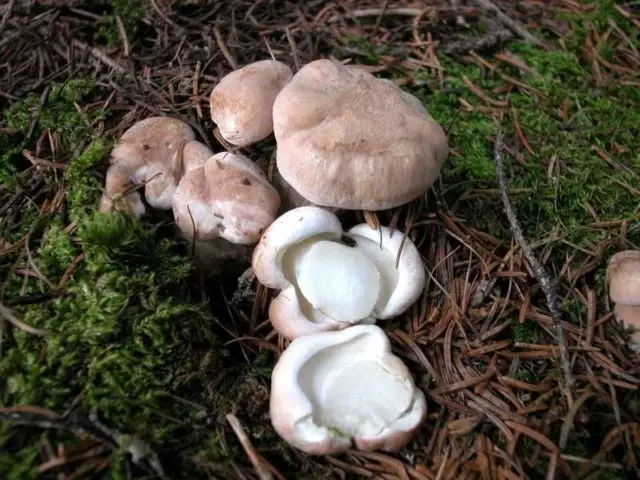
You can also distinguish species by color. As the name implies, the blushing tinder fungus has an orange-reddish color, darker in the center and lighter towards the edges. Merging albatrellus is usually lighter in color.
The blushing species is usually not eaten. It does not belong to poisonous mushrooms, but it is too bitter in taste and therefore not suitable for processing.
Albatrellus comb
This fungus has the same structure and shape as all other related albatrellus. It is also found in Siberia, which increases the likelihood of confusing it with the tinder fungus merging.
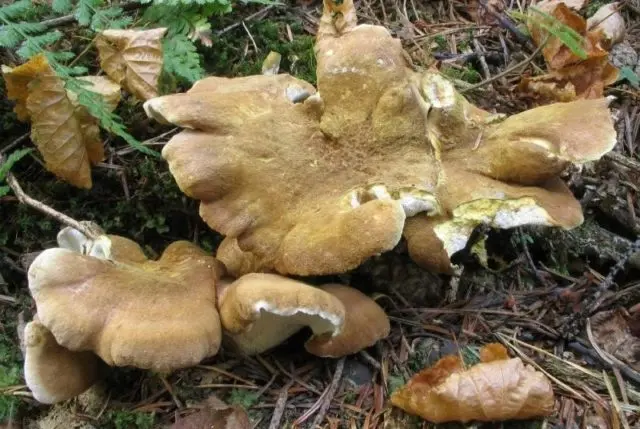
But unlike the fused albatrellus, the combed species has a brighter color. His hat is olive-brown, reddish-rusty, slightly greenish at the edges. The comb tinder fungus is not eaten, because its flesh is too hard, and the taste is unpleasant, although it is not poisonous.
Collection rules
It is better to go to the collection of merging tinder fungus closer to autumn – mushrooms most actively begin to bear fruit from August to the end of September. It is best to look for them in Siberia, in the Urals and in the Murmansk region, in other regions the mushroom is very rarely found, and the chance of finding it is small.
It is necessary to collect merging tinder fungi in environmentally friendly places located away from major roads, industrial factories, landfills and other polluted areas. During the period of its growth, the fungus well accumulates toxins contained in the air, soil and precipitation in the pulp – albatrellus from unfavorable areas can damage health when consumed.
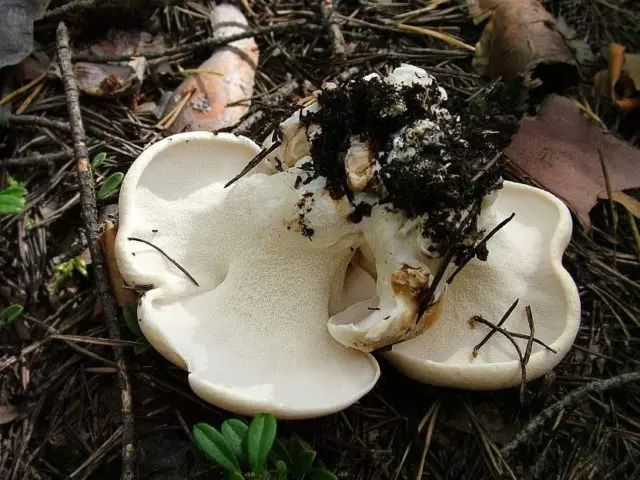
You need to cut the mushroom carefully, trying not to damage its underground part. If the mycelium is destroyed, then subsequently the tinder fungus will no longer be able to germinate in the same place.
Use
The confluent tinder fungus is suitable for consumption even raw, but in practice the fresh pulp is rarely eaten, it may contain toxins from the soil. Usually, the mushroom is boiled before use, for this you need to shake off the adhering debris from it, remove the upper skin from the cap with a knife and boil the pulp with salt for about 15-20 minutes.
After boiling, the merging tinder fungus can be processed by any means. An edible mushroom is fried and stewed, added to soups and consumed as a very tasty independent dish.
Also, the tinder fungus is suitable for harvesting for the winter. It can be pickled and salted, as well as dried. In the latter case, the mushroom is not washed before drying, so that the pulp does not absorb excess water.
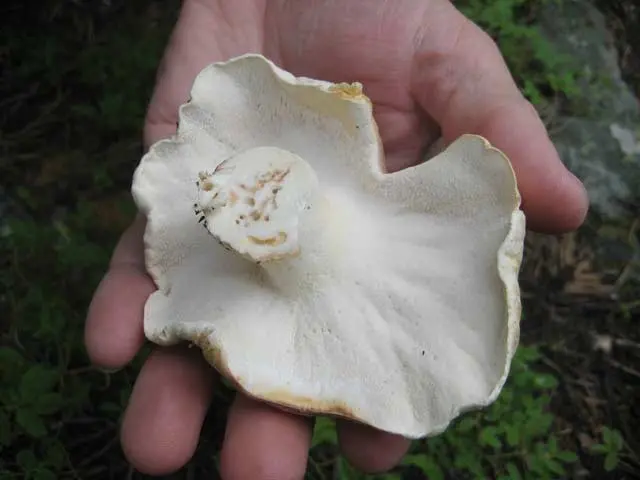
Conclusion
Merging Albatrellus is an unusual-looking, but quite tasty edible mushroom that grows mainly in the Urals and Siberia. It has many similar, but inedible counterparts, so before collecting, you should study the features of different types of tinder fungus and learn how to distinguish them.









